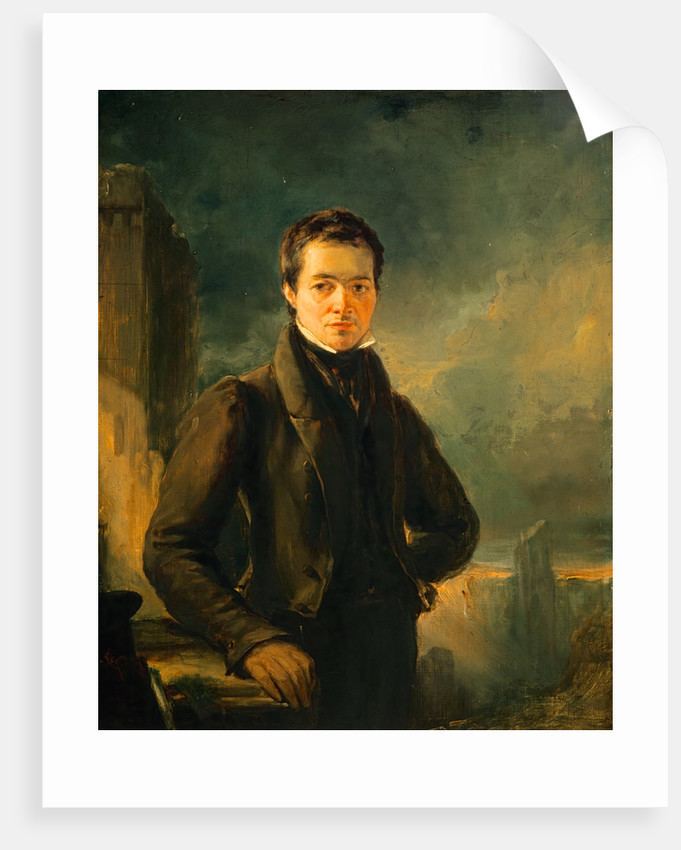Name George Kemp Role Architect | ||
 | ||
Similar People Walter Scott, John Abercrombie, Thomas De Quincey, Agnes McLaren, James Ballantine | ||
George Meikle Kemp (25 May 1795 – 6 March 1844) was a Scottish carpenter/joiner, draughtsman, and self-taught architect. He is best known as the designer of the Scott Monument in central Edinburgh.
Contents

Biography
Kemp was born the son of a shepherd in Moorfoot, Midlothian, near Gladhouse Reservoir on the southern slopes of the Pentland Hills south of Edinburgh. The family moved shortly afterwards to Newhall near Carlops, around 14 miles (23 km) west. He was educated at the school in Penicuik, and was inspired, at the age of ten, by a visit to Rosslyn Chapel and Roslin Castle. In 1809 he was apprenticed to Andrew Noble, a master wright (carpenter) in Redscarhead, near Peebles. During his four-year training he began his own study of the ancient architecture of the Scottish Borders, including Melrose Abbey. After a year working for a millwright in Galashiels, Kemp moved to Edinburgh, working as a carpenter and writing poetry in his spare time.
In 1817, Kemp moved to England, working in Lancashire and travelling, on foot, to draw Gothic architecture as far away as York Minster. He returned to Scotland, basing himself in Glasgow for four years, before moving to London in 1824. Here he continued to study architecture, but could not find permanent employment, so instead set off for France. He spent a year working there, viewing Gothic architecture in Bolougne, Amiens and Paris, before the death of his mother recalled him to Scotland.
In Edinburgh, he attempted to set up as a carpenter and joiner, and meanwhile continued his own studies. He was introduced to the architect William Burn by his brother Thomas, who was employed by the Duke of Buccleuch. Burn engaged Kemp as a competent draughtsman, entrusting him with drawings for Bowhill House, the Duke's seat in the Borders. Kemp also produced a wooden model of a proposed new house for the Duke at Dalkeith. Kemp exhibited his own drawings of Melrose Abbey at the Scottish Academy exhibition of 1830.
In 1832 he married Elizabeth Bonnar, daughter of William Bonnar, an Edinburgh painter whom Kemp would have encountered in the Academy.
Like Walter Scott, Kemp was a Freemason, being initiated in Lodge Edinburgh St Andrew, No.48, in 1827.
Glasgow Cathedral
In the early 1830s Kemp was engaged to produce measured drawings of historic Scottish buildings for a proposed book on Scotland's cathedrals and other antiquities. Although the project was later abandoned, Kemp completed a series of drawings of Glasgow Cathedral, which at that time was incomplete and partly in ruins. He included a drawing showing how the cathedral may have looked, had it been completed as intended, even preparing a model and costs for the works. In 1836, these proposals were publicised by a committee set up to investigate the restoration of the cathedral, although his drawings were attributed to James Gillespie Graham. Kemp was even accused of copying Graham's design, and was not vindicated until 1840. The scheme was later abandoned.
Scott Monument
After the death of the poet and novelist Sir Walter Scott in September 1832, a movement to erect a major monument was begun almost immediately. Fundraising began after a public meeting in Edinburgh in October 1832, and in spring 1836 a design competition was announced. Kemp prepared a design in the space of five days, and submitted it under the pseudonym "John Morvo", the name of a 16th-century master mason who worked on Melrose Abbey. Kemp had feared his lack of architectural qualifications and reputation would disqualify him. A total of 54 competition entries were submitted, of which the top three were to receive premiums of 50 guineas. English architects Thomas Rickman and Charles Fowler were placed first and second; John Morvo's design won the third premium. The identity of John Morvo was revealed by David Cousin, another competitor and a friend of Kemp who was in on the secret.
However, the committee in charge of the competition could not agree on an outright winner, and a second round of contributions was invited. Kemp refined his proposal further, and on 28 March 1838 his scheme was adopted. The committee praised the "beautiful proportions" of the design, declaring that it was, as Kemp intended, "in strict conformity with the purity of taste and style of Melrose Abbey". At the same time, John Steell was commissioned to produce the statue of Scott for the base of the monument. The site, in Princes Street Gardens, was not finally decided until 1840, and work began under Kemp's supervision in March of that year.
Death
However, Kemp did not live to see the completion of his great work. On a foggy Wednesday evening in March 1844 he visited the office of the building contractor, near the end of the Union Canal. Intending to walk along the canal towards his home in Jordan Lane, Morningside, Kemp apparently lost his way in the fog, and fell into the canal and drowned. His body was discovered the following Monday, in the Lochrin Basin, the terminus of the canal, close to the Lochrin Distillery.
He was buried on 22 March in St Cuthberts churchyard in Edinburgh. The grave is in the centre of the first southern section, facing the Scott Monument.
Kemp is also commemorated by a memorial at Moy Hall, Redscarhead, which was formerly the workshop of Kemp's master, Andrew Noble. It was erected in 1932, on the centenary of Scott's death.
Kemp's father-in-law, the painter William Bonnar, oversaw the remaining construction of the Scott Monument. In the autumn of 1844 the last stone was placed by Kemp's son Thomas. The Scott Monument was finally inaugurated, following the installation of Steell's statue, in August 1846.
Kemp's son, Thomas Kemp (1833-1853), was also training as an architect, but died very young.
